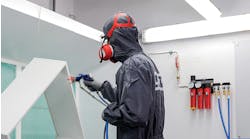The weight savings provided by aluminum, along with related fuel efficiency improvements and other benefits, has made the lightweight metal an appealing material for vehicle manufacturers to work with. However, there are characteristics of aluminum that differ from traditional steel that body shops need to be aware of.
Most notably, body shops must avoid contamination through a process known as galvanic corrosion.
The Ford Motor Company’s introduction of the aluminum-paneled 2015 F-150 pickup truck has made aluminum repair a more prevalent conversation in body shops across the country. According to Ford officials, the F-150 has been the best-selling line of trucks in the United States for nearly four decades.
Seeking to improve towing, payload and fuel efficiency, Ford found high-strength aluminum was the best material to achieve the company’s goals. In addition to increasing dent-resistance, the aluminum paneling saves up of 700 lbs of weight, say company officials.
“This weight savings helps our customers tow more, haul more, accelerate quicker and stop shorter, all with better gas mileage,” they note.
Ford Motor Company (www.Ford.com) is a global automotive and mobility company that designs, manufacturers, markets, finances and services a full line of various vehicles.
BEST PRACTICES
While customers stand to benefit from the advantages of aluminum, body shops are attempting to adopt best practices for working with the material while performing repairs.
“When it comes to repairing aluminum, the lightweight metal is no more demanding than working with steel. It’s just different,” says Geoff Preston of Dent Fix Equipment (www.dentfix888.com) – a manufacturer and importer of body shop equipment.
Adam Smith of BTB Auto Glass and Body Shop Tools adds that aluminum behaves differently than steel. “Steel has a memory,” he says. “It will tend to want to go back to where it was, whereas aluminum doesn’t.”
BTB (www.BTBtools.com) is a manufacturer of tools for the auto glass replacement, collision repair and other industries.
Perhaps the biggest challenge facing body shop technicians is making an initial investment in the proper equipment to perform body service on aluminum vehicles. Cross-contamination can occur, and as a result, galvanic corrosion can harm aluminum, if the same tools are used for steel body work and then used for aluminum jobs.
“Jaguar and Aston Martin and those sorts of companies have been using aluminum for quite a number of years,” points out Smith. “But your average body shop might not see too many Jags or BMWs or Aston Martins, so they didn’t have to worry about equipment. Now that your most-sold vehicle in the country has aluminum on it, they’re going to have to tool up or potentially lose business.”
Galvanic corrosion is an electrochemical process in which one metal oxidizes preferentially to another when both metals are in electrical contact in the presence of an electrolyte.
To further protect work from cross-contamination, Preston advises that body shops focus on the work environment as well.
“Most shops have steel and aluminum work happening in a shared space. This means there are airborne steel contaminants that could contaminate the aluminum panel,” he says. “To avoid this, most car manufacturers require their authorized shops install an aluminum dust collecting system and fume extraction.
“They usually also recommend an aluminum-dedicated work room or area with a special curtain.”
A SIMPLER FIX
Although care must be taken to avoid cross-contamination, Ford officials say that in many ways the aluminum-bodied F-150s will be easier to repair than previous models. Examples of simpler fixes include:
- The apron tube can be repaired without removing the dash.
- The floorpan and rocker panels can be sectioned instead of being completely replaced.
- The B-pillar can be repaired without disturbing the roof.
“The new F-150’s innovative modular structure will significantly reduce time of repair, saving costs,” the officials claim. They add that the company has not restricted any dealers or body shops from purchasing Ford’s OEM collision repair parts for the F-150.
While recommending shops pursue training and purchase proper equipment for aluminum repairs, Ford officials note that the majority of collision repairs to F-150 can be completed by most body shops today. They add the most common damage is to bumpers, grilles and mirrors as well as regular dings and dents to paneling.
NECESSARY EQUIPMENT
To make these aluminum repairs, Ford recommends dedicated equipment, including:
- Aluminum MIG welding system. The welder must be 200V and equipped with Pulse MIG technology.
- Aluminum hand and power tools.
- Aluminum dent extraction system. This system must contain an aluminum stud welder, heat gun, pyrometer, aluminum hammers and dent extraction system.
- Aluminum Wet Mix air filtration system. The dust extraction system must be a Wet Mix technology system and can be a portable or central-installed system.
- Work area separation or isolation system. The work separation can be an aluminum separation system, i.e. curtain, or a separate room.
- Specialized aluminum self-piercing rivet (SPR) rivet gun.
“Collision repair technicians working on aluminum should know how to insert and remove rivets, weld aluminum, remove dents from aluminum panels and properly hold the vehicle for parts removal and replacement,” advise Ford officials. “Technicians should be trained on, and should always, follow OEM-recommended repair practices.”
The need for aluminum-specific tools and equipment will continue to increase as aluminum bodies gain popularity.
“It’s coming sooner than most people think,” says Preston of Dent Fix. “It has long been a desired building material for the super car world for its lightweight properties, which increase performance numbers.”
With aluminum, heavy vehicles, like trucks, can drop a lot of weight to improve fuel mileage, and fleets are always looking for ways to decrease fuel costs, Preston adds. “As manufacturing costs go down, aluminum panels should become the go-to source for manufacturers looking to drop weight.”




